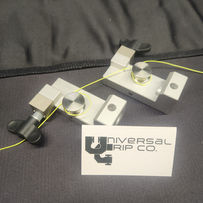ASTM D3822
Single Fiber Tensile Grip


Standard Test Method for Tensile Properties of Single Textile Fiber - PDF
ASTM D3822 is the primary test method for determining the tensile strength, elongation, and modulus of single fibers such as cotton, wool, polyester, nylon, and carbon or glass filaments. It is widely used in:
-
Textile and fiber manufacturing
-
Composite materials
-
R&D and quality control labs
-
Nanofiber and microfiber product testing
The test method is designed to characterize individual fibers, not yarns, fabrics, or composite structures. It provides a fundamental understanding of the fiber’s mechanical behavior.
What Does ASTM D3822 Measure?
-
Breaking force (load at break)
-
Elongation at break (% strain)
-
Tensile strength (breaking force / cross-sectional area)
-
Tensile modulus (optional)
-
Stress-strain behavior of individual fibers
Why is ASTM D3822 Important?
-
Enables material comparison between natural and synthetic fibers
-
Essential for fiber quality grading and performance prediction
-
Supports composite material design, where fiber strength is critical
-
Useful in failure analysis of textiles or high-performance materials
Equipment Required
1. Universal Testing Machine (UTM)
-
Precision load cell with low-force sensitivity, typically in the range of 0.01–50 N
-
Crosshead speed control and data acquisition system
-
Capable of plotting force vs. elongation and calculating stress-strain curves
2. Fiber Tensile Testing Grips
Handling and gripping single filaments is extremely delicate. See below some tips on how to get successful sample breaks.
Two common gripping methods:
a. Paper Tabs ("C"-shaped or folded tabs):
-
The fiber is mounted between paper tabs using adhesive
-
Tabs are clamped in standard mechanical vise grips
-
Prevents slippage and stress concentration at the grips
b. Pneumatic or Capstan Grips for Fine Fibers:
-
Precision grips with low clamping pressure
-
Rubber-faced or cork-lined jaws for gentle holding
-
Some setups use fiber loop wrapping techniques around pins
3. Optical Extensometer (optional)
-
Required for accurate non-contact strain measurement, especially for very fine fibers
-
Alternatively, grip-to-grip displacement can be used for elongation
ASTM D3822 Specimen Preparation
Sample Requirements:
-
Single fiber or filament extracted from a yarn, roving, or staple collection
-
Free from visible defects or contamination
-
Length: typically 25 mm to 100 mm (1–4 in), depending on fiber type
Mounting Techniques:
-
Use a fiber mounting card or tab to hold the fiber aligned and taut
-
Adhesive such as epoxy or cyanoacrylate is used to secure the fiber to tabs
-
Mark the gauge length (distance between grips) before clamping — usually 25 mm (1 inch) or as specified
Conditioning:
-
Standard lab environment: 21 ± 1°C and 65 ± 2% relative humidity
-
Minimum of 24 hours before testing unless otherwise specified
Test Procedure: ASTM D3822
-
Condition the specimens in a standard atmosphere for textiles.
-
Mount the fiber in paper tabs or specialized grips, ensuring straight alignment without slack.
-
Place the fiber in the grips or clamp the paper tabs into the UTM jaws.
-
Set the crosshead speed — commonly 10–20 mm/min depending on fiber length and elasticity.
-
Start the test and apply tensile force until the fiber breaks.
-
Record:
-
Breaking force (N)
-
Elongation at break (%)
-
Tensile strength (MPa or psi)
-
Optional: modulus of elasticity from stress-strain curve
-
Calculating Cross-Sectional Area
Tensile Strength = Breaking Force ÷ Cross-Sectional Area
Where:
-
Breaking Force is the maximum load applied before the fiber breaks (in Newtons or pounds-force)
-
Cross-Sectional Area is based on the fiber’s diameter, assuming it is a perfect circle
To calculate the cross-sectional area of the fiber:
Area = π × (d / 2)²
Or:
Area = (π × d²) / 4
Where:
-
d is the diameter of the fiber (in millimeters, micrometers, or inches)
-
π is approximately 3.1416
So in full:
Tensile Strength = Breaking Force ÷ [(π × d²) / 4]
This will give you tensile strength in units like megapascals (MPa) or pounds per square inch (psi), depending on the units used for force and diameter.
Note:
-
Multiple measurements of diameter along the length are often taken to get an average
-
Irregular or non-circular fibers may require a more complex geometric approximation
Test Report Requirements
-
Type and source of fiber
-
Gauge length
-
Crosshead speed
-
Number of specimens tested (usually 10 or more)
-
Average and standard deviation of:
-
Breaking force
-
Elongation
-
Tensile strength
-
-
Description of gripping method and conditioning
-
Stress-strain curve (recommended)
-
Fiber diameter (and measurement method)
Failure Modes
Commonly observed fiber failure types include:
-
Tensile fracture at center
-
Break near grip edge (may invalidate result)
-
Slippage or pull-out from grip (test must be repeated)
Related Standards
-
ISO 5079 – Tensile testing of individual fibers
-
ASTM D3379 – Tensile strength of high-modulus single-filament materials (e.g. carbon fiber)
-
ASTM D2256 – Tensile test of yarns
-
ASTM D3822M – Metric version of ASTM D3822
Best Practices
-
Always use precision instruments for force and displacement measurements
-
Use anti-vibration supports during testing to avoid data noise
-
Use enough replicates (≥10) to account for fiber variability
-
Calibrate grips to apply minimal clamping pressure
-
Clean fibers of surface treatments or oils if not part of the test scope
-
Double-check alignment — even slight misalignment can introduce bending stresses
Summary
ASTM D3822 is a fundamental test for understanding the tensile behavior of single textile fibers, giving critical insight into the mechanical performance of both natural and synthetic materials. This test is essential for R&D labs, quality control departments, and composite engineers aiming to characterize and optimize raw fibers before they are spun, woven, or compounded into final products.
With the proper sample handling, gripping method, and precision equipment, ASTM D3822 can produce highly reliable and consistent data to support both product development and quality assurance processes.







